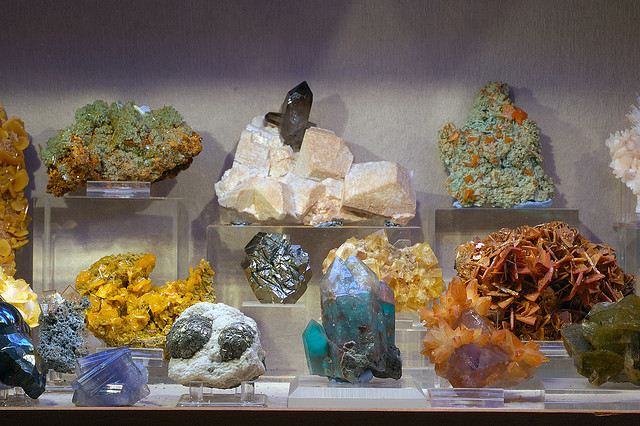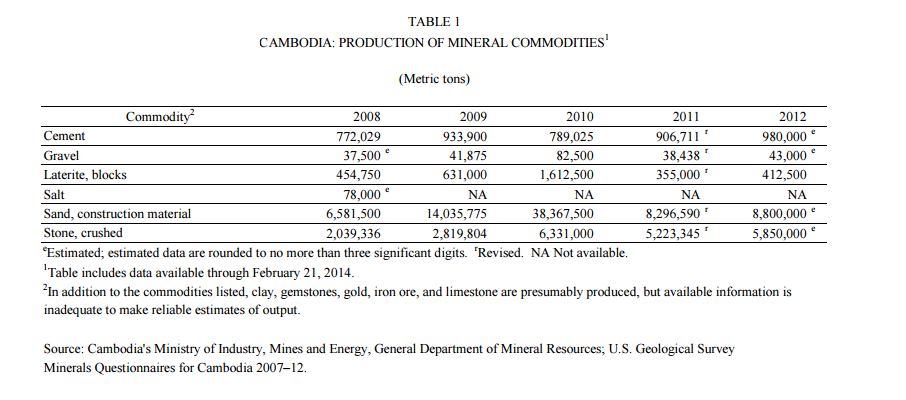
Minerals from Halpern Mineral Collection, San Francisco, Photo by Eric Hunt taken on October 21 2006. License under: CC BY-NC-ND 2.0
Many of Cambodia’s mineral resources are undeveloped, with most production concentrating on construction materials such as crushed stone, sand, gravel and limestone.1
There is currently no large-scale industrial mining. Since the early 2000s, however, the oil and gas sector and land-based minerals including copper, gold, coal and iron have attracted exploration investment from local companies as well as those from Singapore, Thailand, Malaysia, China, South Korea, Australia and the United States.
The first industrial mining in Cambodia for something other than construction materials is most likely to be for gold. The first industrial mining license for gold and associated metals under the new regulatory framework was issued by the Ministry of Mines and Energy to Mesco Gold’s Phum Syarung mine in Ratanakiri in September 2016.2
Legal framework
The Law of Mineral Management and Mining of Cambodia promulgated in 2001 is the main legislation for the sector, covering policies and administration, licensing and royalty payments. The Law on Investment of the Kingdom of Cambodia enacted in 1994 sets out policy for foreign direct investment (FDI) in Cambodia.3Policy aims to encourage foreign investment and business activities by introducing attractive benefits to investors, such as 100% ownership of mining investment with comparatively little government regulation.
The Ministry of Mines and Energy (MME) serves as the main government agency for the sector. Its two main departments, the Department of Geology and Mines and the Department of Energy, administer relevant policy regulations and inspections and assist the private sector. Another separate government entity, the Council for the Development of Cambodia (CDC), is responsible for overseeing the mining sector and provide assistance to companies and investors with regards to business operation in the kingdom.4
Industrial structure and production
At 30 November 2013, 106 local and international mining companies were operating inside the country. 132 exploration licenses were granted for metals, 2 for bauxite, 2 for silica sand and 11 for coal. At the same time, 14 mining licenses were granted, with 4 granted to the gold industry, 1 to the iron industry, 1 for gemstone mining, 7 for limestone mining for cement and 1 for phosphate mining. 5
According to the General Department of Mineral Resources of Cambodia, mineral production grew from 2008 to 2012, with a minor increase from 2011 to 2012. On average, there was an increase between 11% to 16%, with cement growing by 16%, gravel by an estimated 12%, laterite by 16.2% and crushed stone by 12%.6
Last updated: 2 November 2016
References
- 1. Yadira, S and Yolanda, F, 2011. The Mineral Industry of Cambodia. U.S. Geological Survey Minerals Yearbook 2011. http://minerals.usgs.gov/minerals/pubs/country/2011/myb3-2011-cb.pdf
- 2. Angkor Gold Corp. “Cambodian government issues first commercial mining license to Mesco Gold”. Accessed 1 November 2016. http://www.angkorgold.ca/cambodian-government-issues-first-commercial-mining-license-to-mesco-gold/
- 3. Yolanda, F., 2012. The Mineral Industry of Cambodia. U.S. Geological Survey Minerals Yearbook 2012. http://minerals.usgs.gov/minerals/pubs/country/2012/myb3-2012-cb.pdf
- 4. Yolanda, F, Ibid.
- 5. General Department of Mine Resources. Ministry of Mines and Energy. 2014. http://www.mme.gov.kh/administrator/gd-link-page.php?gd1=925
- 6. Yolanda, F, Ibid.


